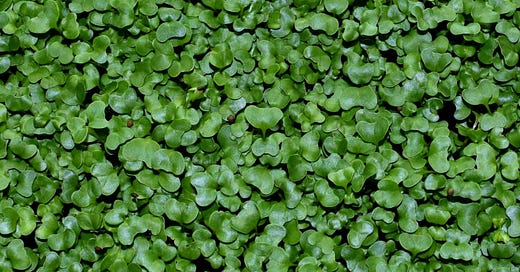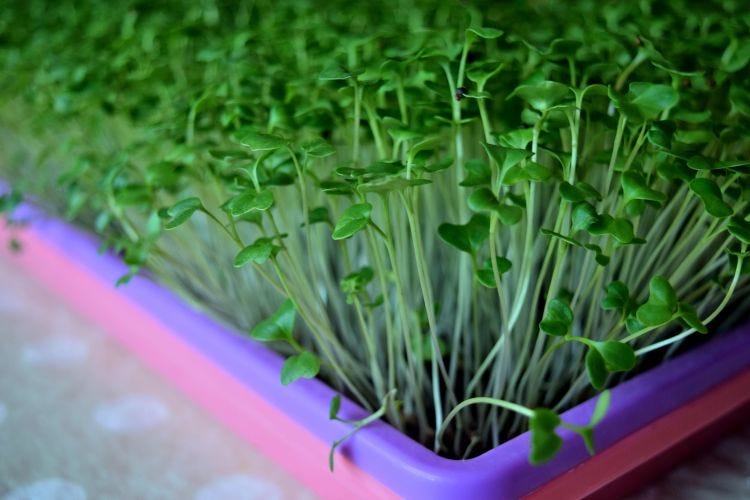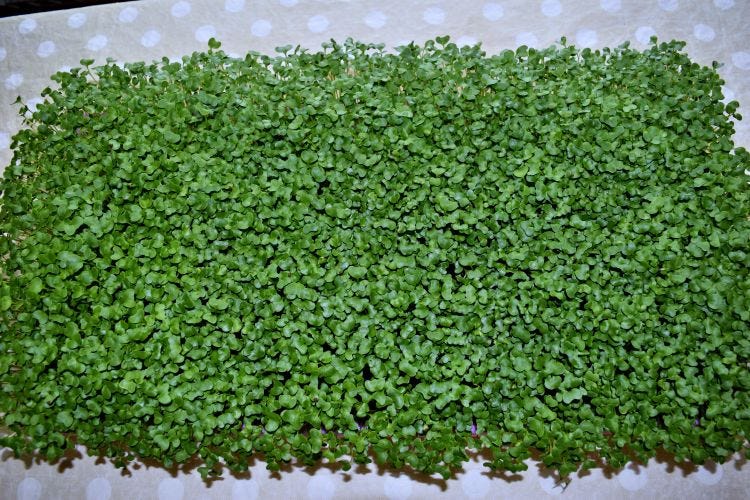Broccoli sprouts are easy to grow and appear to be a favorite among microgreen affectionados. Many microgreen growers include broccoli as one of their microgreen crops and professional microgreen growers report broccoli microgreens are one of their most requested crop by their customers. Broccoli sprouts were popular in the 70’s, but scientific studies done in the 1990’s really gave these sprouts the claim to fame they deserve. Broccoli microgreens are definitely making another comeback as one of the darlings of microgreen growing.
Broccoli seeds can be either sprouted in a jar by soaking the seeds overnight and then rinsing twice daily until the seeds have sprouted. Due to pathogens and bacterial issues of sprouting, broccoli sprouts are finding favor again by being “vertically grown” as in sprouted via the microgreen methods of using soil or other mediums in a tray. I’ve grown them both ways but prefer the microgreen method over the sprouting methods for the reasons stated above.
Broccoli seeds are great to use to make your own blend of seed mix and works well with other sprouts (microgreens) such as onion, alfalfa and fenugreek.
Benefits of Broccoli Microgreens
Contain 30-50 times more gulcoraphanin in the sprouts compared to the mature broccoli plant
Produces sulforaphane which helps detoxify environmental pollutants (benzene and acrotein) and acts as an anti-inflammatory
Nutrition of Broccoli Microgreens
High in Vitamin A and C, calcium, iron and phosphorus
Ten percent more vitamin C than pea shoots
Higher in sulforaphane, also found in kale, mustard, kohlrabi, radish, arugula, watercress, cauliflower, bok choy, collards and brussels sprouts
Broccoli study (1992) – “A Major Inducer of Anti-carcinogenic Protective Enzymes From Broccoli”
Another study (1997) – “The [broccoli] sprouts markedly reduced the incidence, size and number of mammary tumors in lab rats exposed to a standard carcinogen.”
2014 study in Cancer Prevention Research – “…possesses therapeutic properties beneficial in cancers of the colon, breast, spleen and prostate.“
Good for GI disorders by the inhibition of the growth of H. pylori which normalizes DNA methylation and suppresses viral and other disease-related gene expression
Information on broccoli sprouts and autism (see video below starting at 13:49)
Cardiovascular health information (see video below starting at 16:07)
Growing Broccoli Microgreens
Personally I only use organic seeds to grow and one of my favorite varieties is Waltham broccoli. I grow my broccoli microgreen crop in 1020 microgreen trays. I use a two tray system which includes a bottom solid tray that allows me to “bottom water” the crop once it goes under lights and a top tray with slots, one inch deep with which to place the growing medium. I use coco coir to grow my broccoli microgreens.
Germination
I don’t soak my broccoli seeds before planting. I scatter about 20 grams (about 2 tablespoons) of the seeds evenly over the coco coir that I have rehydrated and placed in the slotted microgreen tray (1″ deep and 10″ x 20″ tray hence called 1020 trays). I then place this slotted tray with the coco coir and seeds into a solid bottomed 1″ deep microgreen 1020 tray, nesting one inside the other. I water the seeds well using a fine mist sprayer. I always make sure to spray all the edges and corners well since these are the areas that tend to dry out the fastest.
I use another solid bottomed tray (temporarily) on top of the seeds in an upright position. This tray will be used during the germination period and will be removed once the plants go under the lights. I put weights in this tray above the seeds. I use old magazines in two stacks, each weighing about five pounds, so I’d say about ten pounds total. It is much easier for me to lift five pounds at a time. Microgreens are a crop that is perfect for someone with limited mobility like me.
I water every day, twice a day with a fine mist sprayer and pay attention to the edges and the corners. I work on a plastic table with a plastic tablecloth which makes for easier clean up. I use a dishtowel designated for my grow space only and it is kept handy for wiping up any excess mist or water that gets on the table.
I keep the seeds under weights for 3 days. On the 4th day I turn the upper tray over and place it upside down to act as a “dome” for another 2 days which is referred to as the “blackout” period. I continue misting the seeds twice each day during the entire germination.
Once the seeds reach the blackout stage I start checking for roots emerging through the slots of the tray looking for water. Once roots are seen I mist the bottom tray slightly just to provide some moisture in the bottom tray to encourage the developing roots to find moisture in the tray below. Healthy roots are very white. Brown roots (unless brown from the coco coir) are a sign of dying roots usually due to under watering.
Lights
On the 6th day the seeds are ready to come out from the blackout stage and be placed under lights. My rack sits in front of a window that gets some daylight during certain times of the day and certain times of the year. I have three T5 lights (2200 lumens each) mounted on the bottom shelves of my grow rack. These lights are not special “grow lights”, they are LED lights that are often mounted under kitchen counters, basements or garage work areas. You could use a sunny windowsill, just make sure the microgreens are not placed in hot, direct sunlight for long periods. They prefer indirect sunlight as opposed to harsh, direct light.
Once the tray goes in or under the lights, the watering schedule will still be twice a day but will change from misting overhead to “bottom watering” in the bottom, solid tray. I add a nutrient to the water I feed my crops, it is a liquid that is diluted into water. The product I use is called “Ocean Solution” and I use 2 cap fulls of nutrient liquid to a 2 quart canning jar.
I start most crops with 1/2 cup of water and increase the amount as the crop grows and needs more water. Each day I increase the water slightly, in 1/8 to 1/4 increments, depending on how much (if any) water is in the bottom tray before watering. Always check bottom tray for a guide. Water left over means you are over watering. If the tray is dry and the plants are drooping, you are watering just enough. Droopy plants are thirsty plants. Check the soil moisture with your finger to test for moisture levels and pay attention to the corners and edges of the soil where it is apt to be the driest.
Broccoli is a small seed, has small roots and needs less water than some of the other microgreen crops, like sunflower seeds, peas or wheatgrass with larger roots. Do not over water your crops, to much moisture encourages mold and bacterial growths that could harm your crop and make it inedible.
Harvesting
On day 7 or 8 the sprouts are ready to harvest. I use scissors on finer stems, like broccoli. I have a pair that come apart so they can be thoroughly washed. Gently grabbing a handful at the top of the greens and cutting near the base of the stem without disturbing the growing medium keeps the sprouts cleaner. Any medium that hangs onto the harvested material should be trimmed off before placing in the container for storage. I do not wash my microgreens when harvesting and I don’t harvest right after watering. I want the sprouts to be as dry as possible before storing. I wash the sprouts just before using or serving. Keeping the moisture out of the container discourages bacterial growth.
Microgreens stay fresher if kept in the refrigerator and consumed within one week. I use clamshell containers that I purchased on Amazon. I also recycle containers that I buy produce in at the grocery store. Make sure to wash thoroughly before using a recycled container.
Warning:
Not recommended for people with an iodine deficiency or under active thyroid. Broccoli is a member of the cruciferous family of vegetables and are potentially goitrogenic. It contains certain enzymes that may suppress thyroid gland function and interfere with iodine uptake. This is especially the case when broccoli (or other cruciferous vegetables ) are consumed raw, in large concentrated quantities, as in green juicing.
However, these properties of cruciferous vegetables added to the diet can significantly help lower cancer risk. Broccoli sprouts (and microgreens) included in the diet as a minor portion provide concentrated phytonutrients and therefore the small quantity (served more as a garnish) in the diet offer benefits in the appropriate dose for those with hypothyroidism.
All sprouts contain phytoestrogens but broccoli is not considerably high, unlike alfalfa, clover, pea or fenugreek sprouts or microgreens. These phytoestrogens is something to be aware of if you are seeking to increase or decrease dietary estrogen.
Always check with your medical professional before adding anything new to your diet, especially if you have a chronic condition or are on medications.






